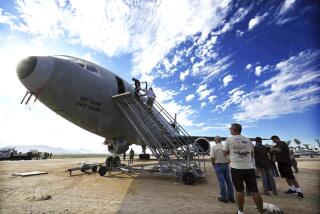The Savvy Traveler : In an Emergency, Medical Kits May Be Lacking
- Share via
The year was 1924. In preparation for the first round-the-world flight, Johnson & Johnson put together an emergency medical kit. It contained bandages, gauze, ammonia, ointment and a splint.
Until recently, most medical kits carried aboard U.S. airlines differed little from that first one.
Despite aircraft and medical technology improving over the years, first-aid kits carried on most planes remain only adequate--for cuts, bruises and the occasional broken finger.
Today, however, public interest groups, some congressmen and a growing number of doctors are lobbying to improve the quality of emergency medical supplies carried aboard airplanes.
In 1981, Ralph Nader’s Aviation Consumer Action Project (ACAP) petitioned the Federal Aviation Authority for a rule that would order improved kits on airplanes.
“Every day,” said the group, “an unknown number of airline passengers develop serious medical problems, some of which may be life-threatening if not properly treated.”
Petition Denied
The FAA denied the petition in 1982. The agency argued that potent and controlled-substance drugs would have to be added to the medical kits, which could create a “possible situation of misuse by unqualified personnel.”
ACAP unsuccessfully appealed the FAA decision.
Then-Arizona Sen. Barry Goldwater argued that the medical kits were “barely minimum for a troop of Boy Scouts.”
He introduced a bill to force U.S. airlines to carry medical kits that could help trained personnel treat heart attacks, allergic reactions, seizures, diabetic comas, choking and bleeding.
“The incidence of serious medical problems or in-flight deaths is very rare,” argues one U.S. airline spokesman. “We’re never far from an alternate airport if we have to land for a medical emergency.”
How many passengers get sick and/or die aloft? It depends on whose statistics you believe and how one interprets those statistics.
For example, a passenger who gets sick on a plane and receives medical treatment after landing is essentially treated in city and state record books as if he got sick at the airport where he was finally treated--not in the air.
The same record keeping applies if the passenger dies in the air. He’s declared dead only after he’s on the ground.
Statistics Vary
Many airlines are reluctant to record these statistics. They vary, they say. Still, the FAA study shows that while a great majority of in-flight deaths are unavoidable, some deaths can be prevented.
And that’s where the medical kits come into play.
For years, foreign airlines have carried extensive emergency medical kits. Air Canada, KLM, SAS, Air New Zealand and Lufthansa are just a few of the carriers that provide an impressive supply of medical supplies and equipment for use in emergencies.
“Foreign airlines have always been more enlightened in the area of emergency medicine,” says Con Hitchcock, legal director of the Aviation Consumer Action Project, a nonprofit industry watchdog. “Why should American passengers have fewer medical protections?”
SAS has a special emergency physician’s kit on board, and the flight attendants make a point of announcing it during the preflight safety demonstration.
Many Lives Saved
“If all airliners had the extensive medical kit that we have on board,” says purser Tage Jensen, “many lives could be saved.”
On SAS and other airlines the kit only can be released by the pilot to qualified personnel.
“We’ve never had a serious incident,” Jensen says, “when we didn’t have a doctor on board as a passenger who could use the kit to administer care.” The same is true at KLM.
Air Canada not only carries extensive medical kits but monitors their use. In one recent year there were 900 reported cases of passenger sickness. The kits were used in 250 of those cases.
UTA French Airlines has three first-aid kits on each plane, plus one for use by a doctor. The doctor’s kit contains 23 medicines as well as special surgical instruments. And the kits are used quite often.
On its African routes, “We’re well known for repatriating many seriously ill French nationals,” Bob Reader, UTA spokesman, said. “And many of these passengers are accompanied by a doctor.”
The good news is that if you’re flying across America, airborne medical care is getting better, at least if you judge by the equipment now carried on U.S. airlines.
While the Goldwater bill never made it through Congress, its introduction did have some impact. The FAA, after reluctantly becoming involved, issued a rule effective in August, 1986, requiring airlines to improve their medical kits.
Took Six Years
“It took us six years to get this rule adopted,” says ACAP’s Hitchcock, “and it’s a step in the right direction. We’ve finally gotten beyond tongue depressors.”
The rule requires U.S. airlines to carry a wide range of supplies and equipment, including a sphygmomanometer (to measure blood pressure), stethoscope, three oral airways, four syringes, six needles, 50% dextrose injection solution, two epinephrine ampules, diphenhydramine HCI injection and 10 nitroglycerine tablets.
And almost every U.S. airline trains its flight attendants in cardiopulmonary resuscitation (CPR).
But according to some experts, the medical kits on U.S. planes are still inadequate.
Many foreign airlines also carry hemostats, scalpels, surgical scissors and pain-killing drugs such as morphine sulfate, amobarbital, diaszepam injection, lidocaine, atropine and prochlorperazine.
These substances are not carried on U.S. airlines because the U.S. Drug Enforcement Agency, objecting to the FAA, fears possible drug misuse.
Another potential danger from medical kits is the possibility of a misdiagnosis in the air by a doctor unfamiliar with a patient/passenger’s medical history. Congress has yet to pass a Good Samaritan law that would absolve doctors from such liability.
“Hopefully,” says ACAP’s Hitchcock, “that bill will be passed soon.”
More to Read
Sign up for The Wild
We’ll help you find the best places to hike, bike and run, as well as the perfect silent spots for meditation and yoga.
You may occasionally receive promotional content from the Los Angeles Times.






